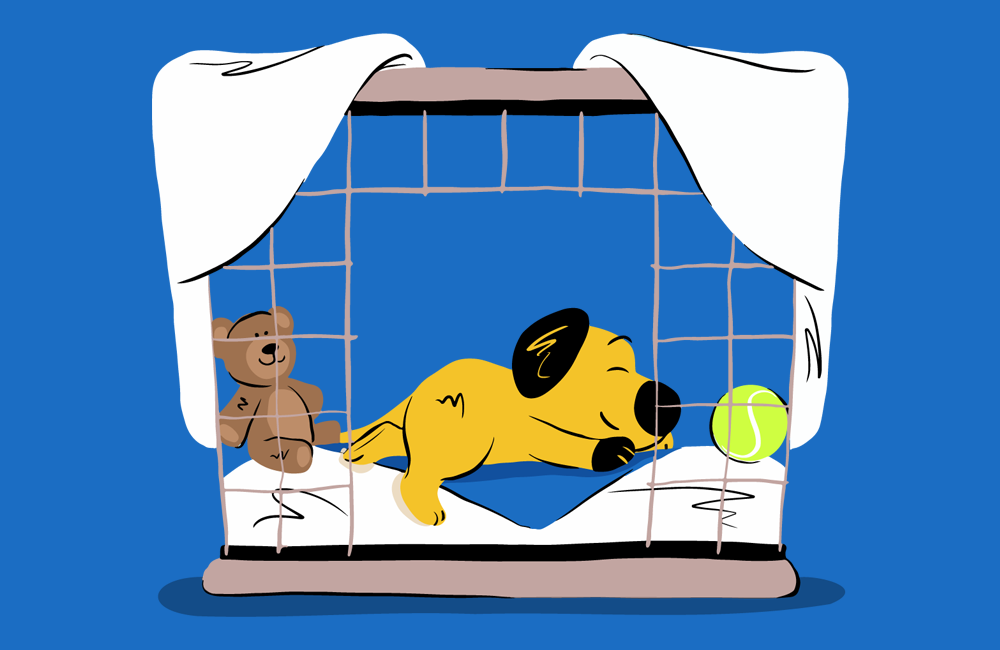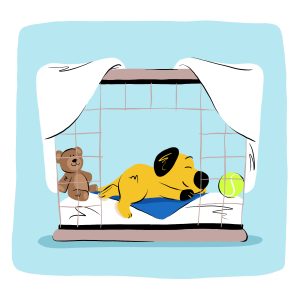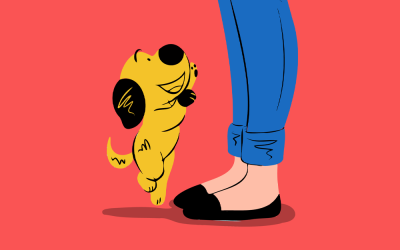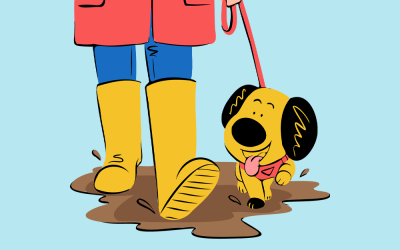How to Crate Train Your Dog in Nine Easy Steps

Written by Petrina Firth, Zigzag Training Coach, Dog Trainer and Behaviorist for Odie Pet Insurance
Crate training your dog can be a game-changer for pups and their owners. They provide a quiet, safe space for rest and comfort while helping to prevent unwanted behaviors.
Whether you’re welcoming a new puppy or an adult dog into your home, mastering this skill can simplify house training as well as provide a sense of security for Fido.
However, it’s not quite as simple as we think, dogs don’t automatically take to them if they haven’t used a crate before, and they need careful and considered training. We want our dog to think calm snug den rather than small prison!
In this guide, we’ll explore nine easy steps to effectively crate train your dog. A life skill that helps with travel, Vet visits and creating a calm place for your dog to take a break.
1. Choose the Right Crate
Choosing the right crate is important.
- Select a crate large enough for your dog to stand, turn around, and lie down.
- Consider your dog’s adult size if they’re still growing.
- Get a crate divider if it’s a large crate, or you can end up with a sleeping end and a bathroom end!
- Choose between wire, plastic, or fabric based on your needs — wire/metal tends to be better for puppies who like to chew zips on soft fabric crates.
2. Build Positive Associations
Teaching your dog the crate is the best place to be is important — food does this best, but toys work, too.
- Place treats and favorite toys inside the crate.
- Feed meals near the crate, gradually moving the bowl closer, so that your dog is eating their meals in there — puzzle feeders and enrichment toys help here.
- Give chews and stuffed Kongs in the crate.
- Have a comfy bed in there and make sure it is warm and cozy.
- Never use the crate as punishment and don’t close the door yet.
3. Introduce the Crate Gradually
Easy does it! Having a crate-trained dog happens with time.
- Leave the door open at all times initially so that your pup can come and go and doesn’t feel trapped.
- Allow your dog to explore at their own pace.
- Toss treats inside to encourage exploration, and teach them to go in and out on cue so you can turn it into a game.
4. Begin Short Duration Training
Once you’ve taught your puppy to go in and out on cue, you can start short durations.
- Use your cue like “crate” or “bed.”
- Start with 5-minute sessions while you’re present and close by.
- It’s much easier if your pup is walked and tried before you start, as they are more likely to relax in the crate.
- Don’t close the door just yet — that will come in time!
5. Extend the Duration
Time to make it a bit trickier for your pup — some find this easier than others.
- Gradually increase the time they go in the crate for.
- Begin closing the door for short periods.
- Stay within sight initially — reading a book is a good way to be present but not engaging with your pup.
6. Practice Going Out of Sight
This can be tough for some pups!
- Try just popping in and out of the room at first — come back in like it’s no big deal.
- Leave the room for brief periods.
- Return before your dog becomes worried.
- Gradually extend your absence.
- If they are sleeping — leave them to sleep!
7. Establish a Routine
Teaching dogs a reliable schedule helps to build confidence, as they know what is coming next in their day-to-day lives.
- Set regular crate times for meals and naps throughout the day.
- Create a consistent bedtime routine.
- Plan regular bathroom breaks so your dog is comfortable.
8. Start Longer Crate Training Sessions
Once your dog is crate-trained you can use it for longer periods.
- Build up to 30-minute sessions during the day.
- Progress to leaving them in the crate while you’re away.
- Ensure they’re exercised before longer periods in the crate — use a playpen or baby-gated area if more than 2 hours (and less for puppies as they often can’t hold their bladder).
9. Maintain the Training
- Continue using positive reinforcement training, so your dog continues to like their crate.
- Keep the crate a pleasant space by using plenty of chews and toys so that it’s interesting.
- Never exceed reasonable time limits as long periods in a confined space can be bad for a dog’s health and physical development.
Tips For Successful Crate Training
- Potty-trained puppies can only hold their bladder for their age in months plus one (e.g., 3 months = 4 hours max). If your puppy isn’t potty-trained, they will struggle to hold it at all, so keep that in mind!
- Always exercise your dog before crating so they are calm and snoozy.
- Remove collars before crating to prevent snagging.
- Place the crate in a quiet, temperature-controlled area.
- If your dog is resting in their crate, don’t let people disturb them — it should be their safe place and sanctuary.
Learn more dog training tips, advice and help with crate training in the Zigzag training app. Download today and access bespoke programs and access our team of professional dog trainers.




